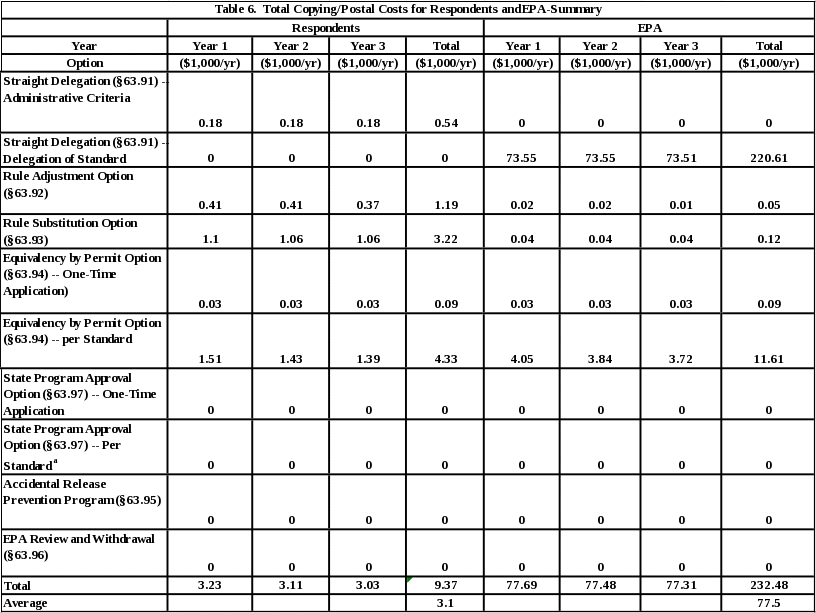1643ss07
1643ss07.docx
Application Requirements for the Approval and Delegation of Federal Air Toxics Programs to State, Territorial, Local, and Tribal Agencies (Renewal)
OMB: 2060-0264
Part A of the Supporting Statement
1. IDENTIFICATION OF THE INFORMATION COLLECTION
1(a) Title of the Information Collection
This Information Collection Request (ICR) is entitled "Application Requirements for the Approval and Delegation of Federal Air Toxics Programs to State, Territorial, Local, and Tribal Agencies" and numbered as EPA ICR Number 1643.07 and Office of Management and Budget (OMB) Control Number 2060-0264. This is a revision of OMB-approved EPA ICR Number 1643.06.
1(b) Short Characterization
This information collection is an application from State, territorial, local, or tribal agencies (S/L/Ts) for delegation of regulations developed under section 112 of the Clean Air Act (Act). In the time frame for this submittal, we, the Environmental Protection Agency (EPA) estimate that the majority of the delegated regulations will be those developed under section 112(d) of the Act. The procedures and requirements that the S/L/Ts will use to request the delegations are codified as 40 CFR 63, subpart E, in accordance with section 112(l) of the Act.
The subpart E regulations contain the following five options for delegation:
Straight delegation
Rule adjustment
Rule substitution
Equivalency by permit
State program approval.
Straight delegation is the option where the respondents, S/L/Ts, choose to accept delegation of a section 112 provision and to implement and enforce the provision as written. The S/L/Ts may use the rule adjustment option when they want to substitute a rule and/or requirement that is unequivocally no less stringent than the otherwise applicable section 112 standard, such as part 63 national emission standards for hazardous air pollutants (NESHAP). They may use rule substitution when they wish to substitute individual rules and/or requirements in place of the otherwise applicable section 112 standard. They may use the equivalency by permit option when they wish to substitute operating permit terms and conditions for a section 112 standard; this option is only applicable to a limited number of sources using title V permit terms and conditions. Finally, S/L/Ts may use the State program approval option if they want to substitute their overall air toxics program for the Federal air toxics program; i.e., the section 112(d) standards.
The delegation options vary in the types of changes allowed, the level of demonstration required, and the amount of time and process needed to implement them. Respondents must submit any packages requesting delegation to their EPA Regional office. We must then review and approve, partially approve, or disapprove the request based on the subpart E approval criteria. The request may only take effect after our approval (or partial approval of a subset of the request), public notice, and, in some cases, public comment.
Subpart E also contains provisions for delegating accidental release prevention program authorities (40 CFR part 68) under the authority of section 112(r) of the Act. In addition, we also reserve the right to review and withdraw an approved S/L/T rule, program, or requirement if we decide it is not as stringent as the otherwise applicable Federal standard or if the S/L/T is failing to adequately implement or enforce it. Subpart E includes the procedures for this the review and withdrawal process.
OMB approved the currently active ICR without any “Terms of Clearance.”
2. NEED FOR AND USE OF THE COLLECTION
2(a) Need / Authority for the Collection
The information is needed and used to determine if the entity submitting an application has met the criteria established in the subpart E rule. This information is necessary for the Administrator to determine the acceptability of approving the S/L/T’s rules, requirements, or programs in lieu of the Federal section 112 rules or programs. The collection of information is authorized under 42 U.S.C. 7401-7671q.
2(b) Practical Utility / Users of the Data
This information is necessary for the proper performance of our functions. The information will have practical utility because we will use the information generated from the collection to ensure that the subpart E approval criteria have been met.
3. NONDUPLICATION, CONSULTATIONS, AND OTHER COLLECTION CRITERIA
3(a) Nonduplication
This information collection is not unnecessarily duplicative of information otherwise reasonably accessible to us. Rather, for instances where other reports required by us would duplicate information required by this rule (for example, the part 70 operating permits rule), it is possible to use information previously submitted to the EPA to meet the requirements of this information collection.
3(b) Public Notice Required Prior to ICR Submission to OMB
An announcement of a public comment period for the renewal of this ICR was published in the Federal Register on October 20, 2010 (75 FR 64722). No comments were received on the burden published in the Federal Register.
3(c) Consultations
The final rule amendments for subpart E were promulgated on September 14, 2000 (65 FR 55810). Since then, we have gained extensive experience in working with the S/L/Ts in delegating section 112(d) NESHAP. We have consulted with knowledgeable EPA staff in the Office of Air Quality Planning and Standards (OAQPS), and Office of Enforcement and Compliance (OECA) as well as each of the EPA Regional Office Air Toxics Coordinators to assess their experience in the type of delegations used by the S/L/Ts, the overall number of delegations granted, and the level of effort expended. We used this information to prepare this ICR renewal package.
3(d) Effects of Less Frequent Collection
Applicants are only required to submit information when they wish to receive delegation of a promulgated section 112 standard. Subpart E specifies the minimum information we require to determine whether their request is approvable. The rule clarifies that the respondent only needs to submit material demonstrating it meets the up-front approval requirements one-time, unless circumstances change at the S/L/T, which would require an updated submittal.
The intent of this voluntary program is to encourage S/L/Ts to accept delegation of the Federal section 112 standards, and to allow them to adjust or substitute S/L/T requirements when they can be shown to be at least as stringent as the Federal requirements. These provisions for alternatives will help preserve existing S/L/T programs and prevent dual regulation of sources.
We also reserve the right to review and withdraw an approved S/L/T rule, program, or requirement if we decide it is not as stringent as the otherwise applicable Federal standard or if the S/L/T is failing to adequately implement or enforce it. In this case, the S/L/T would be asked to submit information regarding permits, monitoring, resources, etc. We will use this information to decide if the rule, program, or requirement should be withdrawn. Our ability to review and withdraw approval is needed to ensure we can satisfy our obligations under the Act to implement and enforce the section 112 standards.
3(e) General Guidelines
These reporting or recordkeeping requirements do not violate any of the regulations promulgated by OMB under 5 CFR part 1320, section 1320.5.
3(f) Confidentiality
Any information submitted to the Agency for which a claim of confidentiality is made will be safeguarded according to the Agency policies set forth in Title 40, chapter 1, part 2, subpart B - Confidentiality of Business Information (see 40 CFR 2; 41 FR 36902, September 1, 1976; amended by 43 FR 40000, September 8, 1978; 43 FR 42251, September 20, 1978; 44 FR 17674, March 23, 1979).
3(g) Sensitive Questions
The reporting or recordkeeping requirements in the standard do not include sensitive questions.
4. THE RESPONDENTS AND THE INFORMATION REQUESTED
4(a) Respondents / SIC Codes
Respondents are S/L/Ts participating in this voluntary program. These government establishments are classified as Air and Water Resource and Solid Waste Management Programs under Standard Industrial Classification (SIC) code 9511 and North American Industry Classification System (NAICS) code 92411. No industries under any SIC or NAICS codes will be included among respondents.
4(b) Information Requested
(i) Data Items, Including Recordkeeping Requirements
The information requirements will vary depending upon the type of option an S/L/T chooses for accepting delegation of the Federal standards. The information requirements are as follows:
For overall approval to receive delegation (§63.91)
Confirmation letter from the State Attorney General.
Demonstration of respondent’s resources.
Copy of the respondent’s statutes, regulations and other requirements that contain appropriate provisions granting authority to implement and enforce the respondent’s rule or program upon approval us.
Respondent’s implementation schedule.
Respondent’s compliance plan.
Respondent’s enforcement plan.
Once respondents have demonstrated they meet the overall approval criteria, they may request straight delegation (§63.91) of the unchanged section 112 standards. This request may be automatic, i.e., the overall delegation established that the respondent agreed to accept delegation of all future NESHAP. Alternatively, the overall delegation may establish a procedure where the respondent requests delegation of individual standards when they are promulgated. Respondents choosing to utilize any of the other options to demonstrate the equivalency of their requirements to the Federal requirements must supply the following information:
For the rule adjustment option (§63.92):
Stringency and compliance demonstration.
For the rule substitution option (§63.93):
Demonstration of S/L/T rule equivalency with the otherwise applicable Federal standard.
For the equivalency by permit option (§63.94):
A list of affected sources and standards within the respondent’s jurisdiction.
Draft permit terms and conditions.
Demonstration of the equivalency of S/L/T permit terms and conditions to the otherwise applicable Federal standard.
For the State program approval option (§63.97):
Source categories for submission within the respondent’s jurisdiction.
Description of enforcement measures for area sources (if the otherwise applicable Federal standard applies to area sources).
Collection of the respondent’s rules, regulations, permits, implementation plans, or other enforceable mechanisms.
Equivalency demonstration of respondents’ alternative rules to the otherwise applicable Federal standard.
For the accidental release prevention program (§63.95):
Demonstration of adequate resources.
Demonstration of adequate enforcement authority.
Description of coordination mechanisms.
We also have the option of withdrawing a program if we decide that the S/L/T is not properly implementing its rule or program in lieu of the otherwise applicable Federal standard. Under the EPA review and withdrawal option (§63.96), the respondents must submit the following:
Information regarding permits, monitoring, resources, etc.
(ii) Respondent Activities
The respondent activities required by the rule are listed in the Table 1a through 1g. These activities vary by option because of the different types of information required under each option. To the maximum extent practicable, these activities were developed to allow the S/L/Ts to respond in ways that are consistent and compatible with their existing reporting and recordkeeping practices. Note that we only anticipate activities related to delegation options described in Tables 1a through 1d during the 3-year approval period.
5. THE INFORMATION COLLECTED -- AGENCY ACTIVITIES, COLLECTION METHODOLOGY, AND INFORMATION MANAGEMENT
5(a) Agency Activities
This section addresses the activities to review the applications submitted by the S/L/Ts under subpart E. The activities vary according to the option used by the S/L/T and are as follows:
For the overall approval to receive delegation (§63.91):
Create a Federal Register notice seeking public comment.
Review public comments.
Evaluate the S/L/T submittal.
Create a Federal Register notice announcing approval or disapproval of the S/L/T submittal.
For the straight delegation of individual standards, the Agency will either automatically delegate them to the S/L/T or delegate them in response to a written request, depending on the mechanism established via the overall approval. If the S/L/T decides to use any of the other options listed within subpart E to demonstrate the equivalency of their rules to the Federal rule, then we will complete both the following activities listed in the applicable option below.
For the rule adjustment option (§63.92):
Create a Federal Register notice seeking public comment.
Review public comments and S/L/T responses.
Evaluate the S/L/T submittal.
Create a Federal Register notice announcing the approval or disapproval of the S/L/T submittal.
For the rule substitution option (§63.93):
Create a Federal Register notice seeking public comment.
Review public comments and S/L/T responses.
Evaluate the S/L/T submittal.
Create a Federal Register notice announcing approval or disapproval of the S/L/T submittal.
For the equivalency by permit option (§63.94):
Create a Federal Register notice seeking public comment on the up-front approval of the S/L/T submittal.
Review public comments and S/L/T responses.
Create a Federal Register notice announcing approval or disapproval of the S/L/T up-front submittal.
Evaluate the draft permit terms and conditions submitted by the S/L/T.
Create a final Federal Register notice announcing approval or disapproval of the draft permit terms and conditions.
For the State program approval option (§63.97):
Create a Federal Register notice seeking public comment on the up-front approval of the S/L/T submittal.
Review public comments and S/L/T responses.
Create a Federal Register notice announcing approval or disapproval of the S/L/T submittal.
Create a Federal Register notice seeking public comment on the specific alternative rule submitted by the S/L/T.
Review public comments and S/L/T responses.
Evaluate the equivalency demonstration submitted by the S/L/T.
Create a final Federal Register notice announcing approval or disapproval of the alternative rules submitted by the S/L/T.
For the accidental release prevention program (§63.95):
Evaluate and approve or disapprove the S/L/T submittal.
Furthermore, we reserve the right to review and withdraw a S/L/T rule or program if we decide that the program is not as stringent as the otherwise applicable Federal standard. During the EPA review and withdrawal option (§63.96), we conduct the following activities:
Request information from the affected S/L/T.
Evaluate technical information, data, and results of any site visits within the jurisdiction of the S/L/T.
Create a Federal Register notice announcing our intent to withdraw the S/L/T program or rule.
Evaluate public comments and S/L/T responses.
Create a Federal Register notice announcing the final decision.
The EPA activities required by the rule and the technical hours associated with them are found in Tables 2a through 2g. Note that we only anticipate activities related to delegation options described in Tables 2a through 2d during the 3-year approval period.
5(b) Collection Methodology and Management
All S/L/Ts using subpart E to accept delegation of Federal standards must submit the proper application to us for review and evaluation. They should prepare their applications using guidance we issued in April 2001 to facilitate subpart E implementation. This guidance is available on the internet at www.epa.gov/ttn/atw/112(l)/112-lpg.html. The regulations contain no forms.
Qualified staff that work for the EPA Regional offices as well as EPA Headquarters will review the subpart E applications. The S/L/Ts must supply any calculations and assumptions supporting the technical portion of the application, and we will review these supporting materials to verify them. In regard to information management, we have planned and allocated resources for the efficient and effective use of the information, including the processing of the information in a manner which enhances the utility of the information to us and to the public. For example, in most cases, existing S/L/T part 70 operating permit program approvals may be used to meet the up-front approval criteria in §63.91.
The subpart E regulations do not require the request of information through any type of survey.
Most delegation requests are submitted in hard copy. Submitting agencies are encouraged to work with their applicable EPA Regional office to determine if there are procedures to follow if they wish to use an electronic format. Approvals still have to be sent to the Federal Register for publication, but courtesy copies can be sent to S/L/Ts via e-mail.
5(c) Small Entity Flexibility
Minimizing the information collection burden for all sizes of organizations is a continuing principle for our efforts. The subpart E regulations only include the application, recordkeeping and reporting requirements we need to determine compliance with the rule. We have reduced the collection burden to the extent practicable and appropriate, including consideration of the resources available to the respondents and clarifying, consolidating, and simplifying the requirements. Furthermore, we do not anticipate that any small entities will be participating in this program.
5(d) Collection Schedule
The schedule is tied to the promulgation of Federal section 112 standards. As these are issued, S/L/Ts may request delegation. Each S/L/T may submit an application under one of the five options discussed in section 1(b). Preparation of an application in compliance with subpart E is a one-time per standard activity. The subpart E regulations do not require periodic reporting or surveys.
6. ESTIMATING THE BURDEN AND COST OF THE COLLECTION
6(a) Estimating Respondent Burden
This ICR requires the calculation of the amount of burden hours associated with each activity for each respondent (S/L/T) when complying with the subpart E regulations. In calculating the burden hours for subpart E, we made assumptions about the number of S/L/Ts that would use each option as well as the total number of Federal standards delegated by each option. We also made assumptions about the type and level of regulatory activity that would result in delegations. During this ICR collection period (2011 – 2014), there are three types of section 112 standards potentially relevant to subpart E delegation. First, the section 112(d) maximum achievable control technology standards (MACT) that predominantly apply to major source emitters have all been promulgated, and the majority of MACT standards have been delegated to those S/L/Ts willing to accept delegation. In the upcoming clearance period we anticipate that there will be 40 delegation requests for the remaining standards. For example, in EPA Region 6, most States still need to adopt the boiler MACT standards.
We are currently working to propose and promulgate several standards under the section 112(k) area source program. We anticipate that 11 of these standards will be promulgated during the next ICR collection period, but there is less certainty regarding the number of S/L/Ts that will accept delegation of these standards. In some cases, the S/L/Ts have automatic delegation for all section 112(l) standards (e.g., Region VIII S/L/Ts), but other Regions have indicated there may be cases where because of resource constraints, a limited number of affected sources, and/or a sense that the State rules are more restrictive than the Federal rules, not all S/L/Ts will accept delegation of these rules. For purposes of this analysis, we estimate that 80 percent of the S/L/Ts will accept delegation of the area source rules.
Based on our consultations as described in section 3(c) and information on the status of the regulatory development efforts, we assumed that 119 S/L/Ts will continue to maintain their subpart E program for the MACT standards. Thus, the annual effort for all S/L/T results in a total of 357 occurrences during the 3-year clearance period.
As described earlier, we assumed that there will be 40 delegation requests (occurrences) for MACT standards during the clearance period by each of the 119 S/L/Ts. Therefore, it is expected that there will be a total of 4,760 delegation requests. Based on input from the Regional coordinators, we think that 2 of these will be equivalency by permit, 36 of these will be rule substitutions, and 3 will be a rule adjustment. The number of straight delegations was estimated by subtracting the other delegation options from the total number of delegation requests. As a result, it is estimated that there will be a total of 4,719 straight delegation requests during the 3-year clearance period. Figure 1 illustrates the number of occurrences for each option. One reason that these remaining MACTs are still pending is that the S/L/Ts and Regions are still working on the alternative in rules or permits. The total number of occurrences shown in Figure 1 is 5,119.
In the case of area source standards, we assumed that 11 will be promulgated during the 3-year clearance period and that 80 percent (79) of the S/L/Ts will take delegation. We assumed the same distribution of delegation options as in 2007 for this group of standards, i.e., 80 percent straight delegation, 3 percent rule adjustment, 5 percent rule substitution, 12 percent equivalency by permit. Of these, we assumed half (6 percent) would need to obtain initial approval to use the equivalency by permit options. The percent of MACT standards delegated per option was multiplied by the total number of S/L/T taking delegation (79). The Equivalency by Permit Option is a two-step process. We assumed participates of this option that are undergoing step two of the delegation process lacked initial approval. We also assumed that one S/L/T might seek to use the program approval option during the 3-year period. Using this methodology, as illustrated in Figure 2, we calculated the number of occurrences for each option, resulting in an average number of responses per year of 306.
The average number of responses per year for both, MACT and Area Source standards is 2,013. Table 3 below summarizes the number of occurrences of delegated request by MACT and Area Source standards.
In calculating the burden hours associated with each delegation option, we retained the same activities and burden hour estimates used in the previous ICR (ICR Number 1643.06) for subpart E
The total hours associated with each option in tables 1a through 1g are for technical hours only. Consistent with the previous ICR, we calculated management hours as 5 percent of technical hours and clerical hours as 10 percent of technical hours. Table 4a contains the results of the burden hours calculation for each activity during each year of this ICR. Overall, the promulgated subpart E regulations contain an average burden of 37,107 hours per year.
6(b) Estimating Respondent Cost
(i) Estimating Labor Costs
This ICR uses the following labor rates:
Managerial $60.99 ($38.12 + 60%)
Technical $35.41 ($22.13 + 60%)
Clerical $26.17 ($16.36 + 60%)
Labor rates, on a per-hour basis, are from the United States Department of Labor, Bureau of Labor Statistics, Occupational Employment Statistics, May 2009. The occupational category that is the most similar to State and local personnel affected by this rule is assumed to be an average (mean) of “State Government” and “Local Government.” This ICR uses the labor rates for the following occupations within this category: for technical labor, environmental science and protection technicians; for managerial labor, all other managers; for clerical labor, secretaries. The hourly mean wage rates plus 60% of the hourly rate for overhead and benefits are included in the per-hour labor rates used to estimate respondent costs. The resulting rates used are $60.99 for management, $35.41 for technical personnel, and $26.17 for clerical personnel.
The respondent labor costs are found by multiplying the burden hours associated with each activity by the hourly rate associated with each labor type. In total, the subpart E regulations contain an average labor cost of $1,352,000 per year. Table 4a contains the results of the calculation of labor costs for the respondents.
(ii) Capital / Start-up Costs
This ICR does not require any capital or start-up costs for equipment, machinery, and construction.
(iii) Operating and Maintenance (O&M) Costs
Respondents who choose to request delegation under subpart E must submit a complete application, which results in photocopying and postage costs. We determined that two types of documents would be both copied and mailed: 2-ounce letters and 1-pound packages. The 2-ounce letter would contain 5 pages, and the 1-pound package would contain 200 pages. Based on the typical price to copy a page, we used $0.06 a page as our price per unit cost of copying. The cost for mailing a 2-ounce letter and 1-pound package via the United States Postal Service is $0.61 and $4.75, respectively. We also assumed that a total of three copies would be made for each letter or package. Tables 5a through 5d show the activities that would require copying and postage. Table 6 summarizes the total copying and mailing costs per year. For respondents, the average cost for copying and postage is $3,100 per year. Therefore, the average total cost to respondents, including labor cost of $1,352,000 per year and copying/postage cost is $1,355,100 per year. Table 7 shows this breakdown by year.
6(c) Estimating Agency Burden and Cost
Under the subpart E regulations, we must review and evaluate the subpart E applications submitted by the S/L/Ts. In reviewing and evaluating these applications, we will carry out the activities listed in section 5(a) of this ICR. Managerial activities are considered 5 percent of the technical hours while clerical activities are considered 10 percent of the technical hours.
This cost is based on the following hourly labor:
Managerial $86.56 (GS-15, Step 5, $54.10 + 60%)
Technical $52.37 (GS-12, Step 5, $32.73 + 60%)
Clerical $26.56 (GS-6, Step 5, $16.60 + 60%)
These rates are from the Office of Personnel Management (OPM), 2010 General Schedule, which excludes locality rates of pay. The rates have been increased 60 percent to account for the benefit packages available to government employees.
The EPA labor costs are found by multiplying the burden hours associated with each activity by the hourly rate associated with each labor type. Overall, the average burden hours for EPA is 26,067 hours per year. Table 4b contains a breakdown of EPA burden hours per year. The average labor cost for the EPA is $1,345,000 dollars per year. Table 4b contains a breakdown of EPA labor costs per year. Copying and postal costs for the EPA were calculated in the same manner as described in the last paragraph of section 6(b). Tables 5a through 5d contain a detailed listing of EPA copying and postal costs. Table 6 presents the total EPA copying and postal costs. The EPA would spend an average of $77,500 on copying and postage. The total cost for EPA, including labor and copying/postal costs would be an average of $1,423,000 per year. Table 7 shows a breakdown of the total cost for the EPA by year.
6(d) Estimating the Respondent Universe and Total Burden Costs
In order to estimate the number of S/L/Ts participating in the subpart E program, we obtained information from the EPA’s Regional Air Toxic Coordinator contacts regarding subpart E delegation activity in their Regions. We determined that 119 agencies are participating in the subpart E program. The breakdown of these agencies is as follows: 49 State agencies, 2 territorial agencies, and 66 local agencies.
6(e) Bottom Line Burden Hours and Cost
(i) Respondent Tally
Over the 3-year period of this ICR, the total average annual burden and labor cost for the respondents resulting from the subpart E regulations are 37,107 hours and $1,352,000, respectively. Table 4a contains the bottom line estimate of burden hours and labor cost associated with the subpart E regulations. There is no capital start-up costs associated with this collection. Operation and maintenance costs result from photocopying and postage expenses, which are a total of $3,100 per year. Table 6 shows the O&M costs. The total average annual cost to respondents is $1,355,100. Table 7 contains the total estimate of costs associated with the subpart E regulations.
(ii) Agency Tally
Over the 3-year period of this ICR, the total average annual burden and labor cost for the EPA is 26,067 hours and $1,345,000, respectively. Table 4b contains the bottom line estimate of burden hours and labor cost associated with the subpart E regulations. Operation and maintenance costs result from photocopying and postage expenses, which are a total of $77,500 per year. Table 6 shows the O&M costs. The total average annual cost to EPA is $1,423,000. Table 7 contains the total estimate of costs associated with the subpart E regulations.
6(f) Reasons for Change in Burden
The currently approved reporting and recordkeeping hour burden, based on ICR Number 1643.06, is 62,844 hours per year. We are requesting a decrease in burden to 37,107 hours per year.
The change in burden results from: (1) a decrease in the number of S/L/Ts taking delegation, (2) an increase number of occurrences related to the number of NESHAP delegated and (3) a change in the distribution of S/L/Ts using each option when delegating MACTs. These changes are discussed below.
The total number of occurrences increased from 399 to 5,119 for MACT standards partially due to the number of MACT standards being delegated increasing from 24 to 40. However, the number of delegations decreased from 124 to 119. The significant increase was largely due to a calculation error in determining the number of straight delegations in the previous ICR. The previous ICR estimated 12 occurrences of straight delegations during the clearance period while we calculated 4,719 occurrences for the upcoming 3-year period. The total number of occurrences decreased for area source standards from 4,177 to 920 due to the number of area source standards decreasing from 40 to 11 and number of delegations dropping from 99 to 79.
Second, based on the experience the EPA’s Regional Air Toxics Coordinators have had with the subpart E program, S/L/Ts’ use of the various delegation options has changed for MACTs. Straight Delegation is still the primary delegation mechanism and has significantly increased in frequency since the previous ICR. However, we found that S/L/Ts are using the Rule Adjustment Option and the Rule Substitution Option with greater frequency than previously assumed. Generally, sources do not use the State Program Approval Option.
Overall, the respondent hour burden has decreased. Table 8 below breaks down these changes by option. While there is an overall increase in the amount of occurrences, the overall burden decreases by 41 percent due to the significant increase in use of the straight delegation option which requires less hours than the other options.
Similarly, the respondent average total labor cost per year decreased by $1,608,000 (or 54 percent). The breakdown by option within the subpart E program is shown in table 9 below. Increases or decreases in the total average annual cost for the options reflect the change in the amount of burden for that particular option. The amount of change differs from the change hours, which is largely due to increases in the average labor wage rates. These rates were updated to reflect current estimates.
While mailing costs have increased, we are requesting a decrease in the reporting and recordkeeping cost burden due to an error in the postal costs reported in the previous ICR. Some of the EPA mailing costs were incorrectly included in the sums for Respondent costs, thus decreasing the overall costs. Our assumptions for copying and postage costs are discussed in section 6(b). The total copying and postage cost for S/L/Ts is $3,100 per year, of which 80 percent is associated with obtaining straight delegation of the NESHAP.
6(g) Burden Statement
The annual public reporting and recordkeeping burden for this collection of information is estimated to average 18 hours per response.
Burden means the total time, effort, or financial resources expended by persons to generate, maintain, retain, or disclose or provide information to or for a Federal agency. This includes the time needed to review instructions; develop, acquire, install, and utilize technology and systems for the purposes of collecting, validating, and verifying information, processing and maintaining information, and disclosing and providing information; adjust the existing ways to comply with any previously applicable instructions and requirements; train personnel to be able to respond to a collection of information; search data sources; complete and review the collection of information; and transmit or otherwise disclose the information.
An agency may not conduct or sponsor, and a person is not required to respond to, a collection of information unless it displays a currently valid OMB control number. The OMB control numbers for EPA’s regulation are listed in 40 CFR part 9 and 48 CFR chapter 15.
To comment on the Agency's need for this information, the accuracy of the provided burden estimates, and any suggested methods for minimizing respondent burden, including the use of automated collection techniques, EPA has established a public docket for this ICR under Docket ID Number EPA-HQ-OAR-2004-0065. An electronic version of the public docket is available at http://www.regulations.gov/ which may be used to obtain a copy of the draft collection of information, submit or view public comments, access the index listing of the contents of the docket, and to access those documents in the public docket that are available electronically. When in the system, select “search,” then key in the docket ID number identified in this document. The documents are also available for public viewing at the Air and Radiation Docket and Information Center in the EPA Docket Center (EPA/DC), EPA West, Room 3334, 1301 Constitution Avenue NW, Washington, DC. The EPA Docket Center Public Reading Room is open from 8:30 a.m. to 4:30 p.m., Monday through Friday, excluding legal holidays. The telephone number for the Reading Room is (202) 566-1744, and the telephone number for the Air and Radiation Docket Information Center is (202) 566-1742. Also, you can send comments to the Office of Information and Regulatory Affairs, Office of Management and Budget, 725 17th Street, NW, Washington, D.C. 20503, Attention: Desk Officer for EPA. Please include the EPA Docket ID Number EPA-HQ-OAR-2004-0065 and OMB Control Number 2060-0264 in any correspondence.
Part B of the Supporting Statement
This part is not applicable because no statistical methods were used in collecting this information.
FIGURES
Figure 1. Allocation of Subpart E Delegation Options-MACT Standards
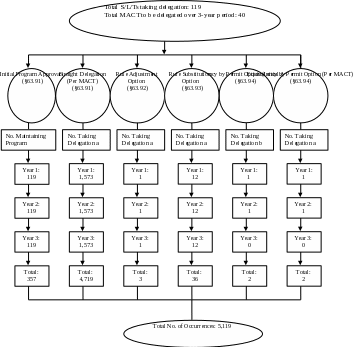
a Each MACT is delegated to one S/L/T. The number of agencies taking delegation is equal to the number of MACTs.
b Equivalency by Permit is a two-step process. We assumed S/L/Ts taking delegation under the second step do not already have initial approval.
Figure 2. Allocation of Subpart E Delegation Options-Area Source Standards
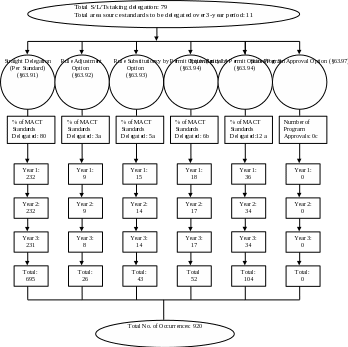
a Each MACT is delegated to all 79 agencies. The percent of MACT standards delegated per option is multiplied by 79.
b Equivalency by Permit is a two-step process. We assumed that half of the S/L/Ts taking delegation under the second step do not already have initial approval
C We assumed no agency would seek State Program Approval during the clearance period.
TABLES

†For this renewal period, we assumed that all agencies have already completed activities
A-K and have received up-front delegation.
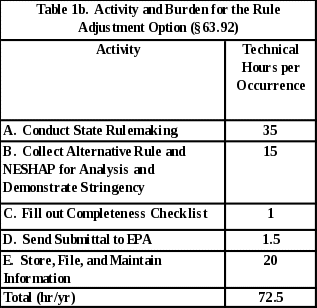
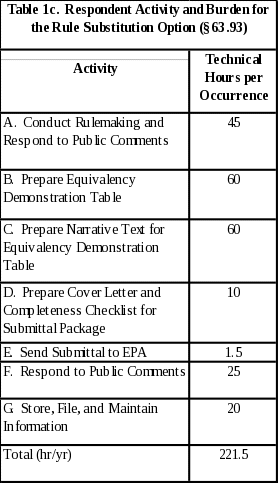
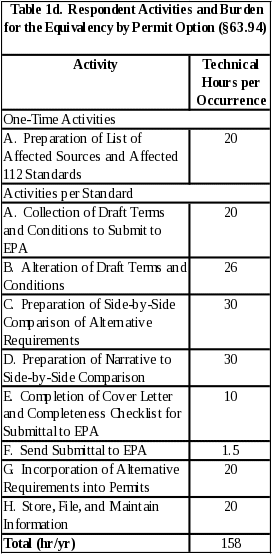
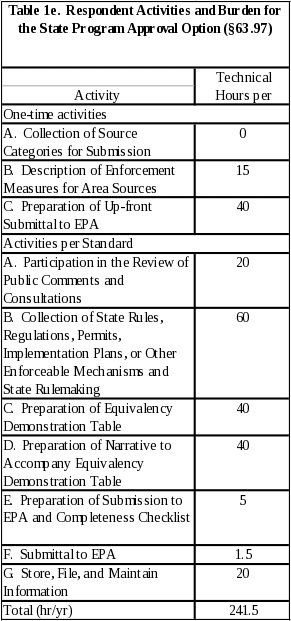
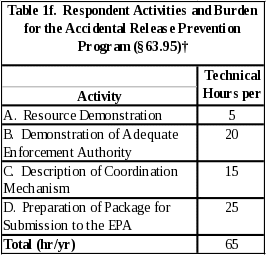
†Not expected to use this option during 3-year period.

†Not expected to use this option during 3-year period.
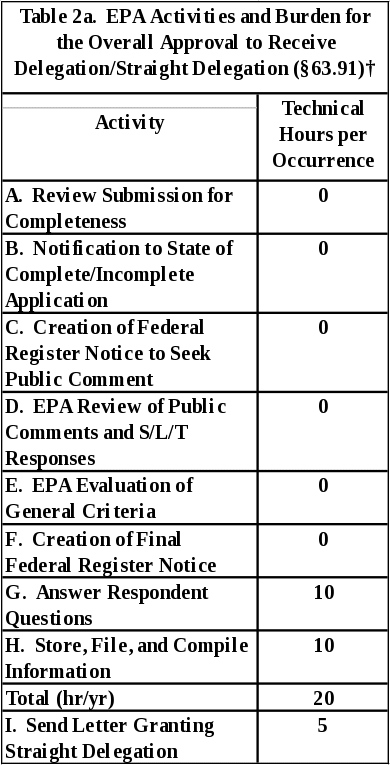
†For this renewal period, we assumed that all agencies have already
completed activities. A-F and have received up-front delegation.
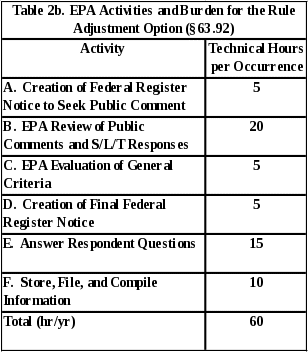
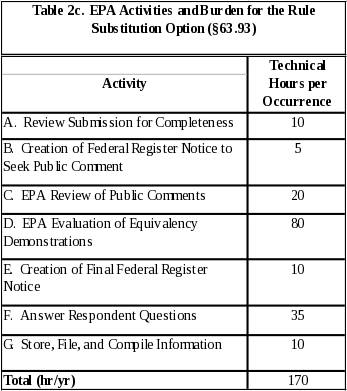

† Assumes that any up-dates by the respondent to the list of affected sources and standards will
be incorporated as part of any individual requests.

†Not expected to use this option during 3-year period.
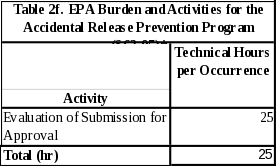
†Not expected to use this option during 3-year period.
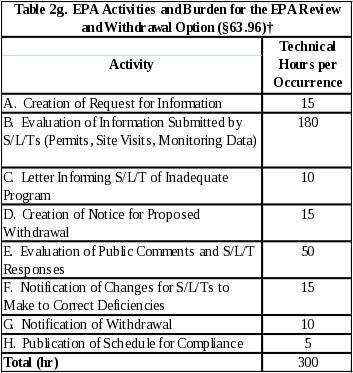
†Not expected to use this option during 3-year period.
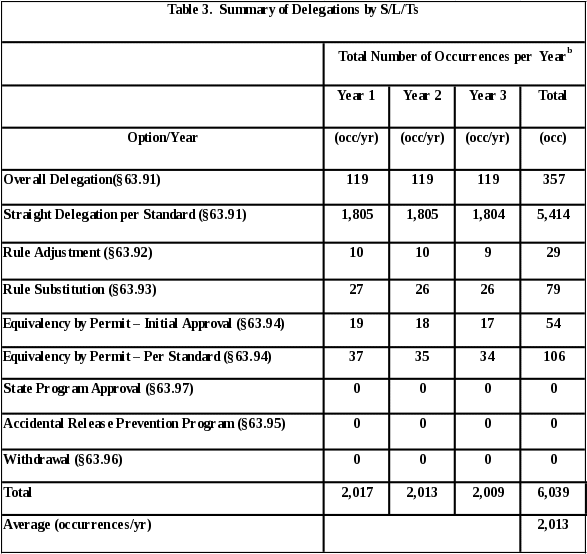
b Number of occurrences is the sum of MACT standards delegated and area standards delegated (See Figures 1 & 2).

a Combined with one-time costs, above.
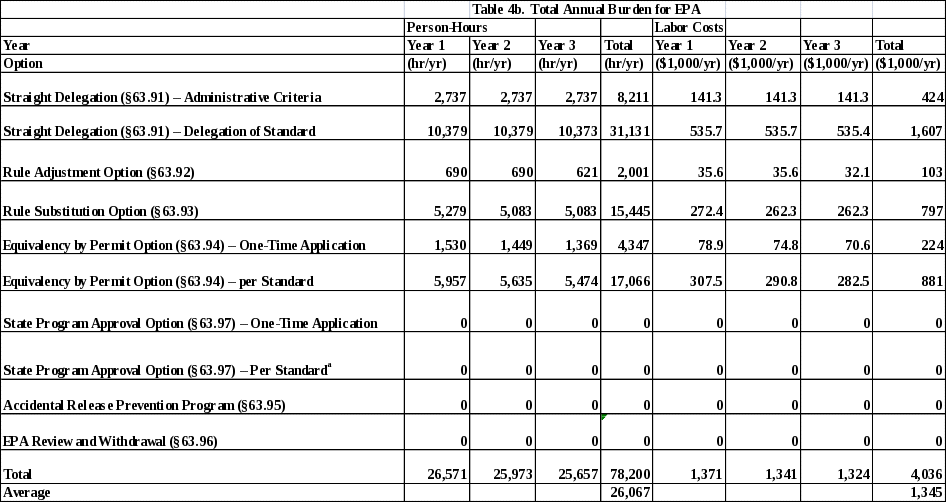
a Combined with one-time costs, above.

†Falls under maintenance of subpart E program approval.
‡Falls under the Straight Delegation Option.
aAssumes 2-oz. letter.
bAssumes 1-lb. package.
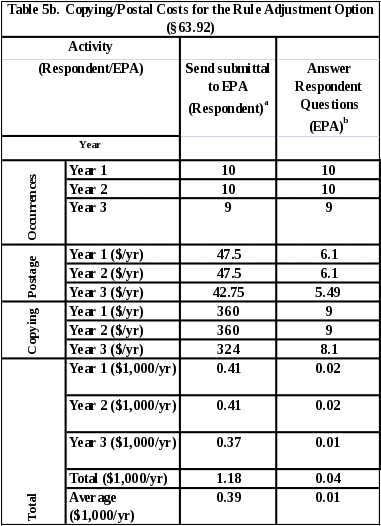
aAssumes 1-lb. package.
bAssumes 2-oz. letter.

aAssumes 1-lb. package.
bAssumes 2-oz. letter.
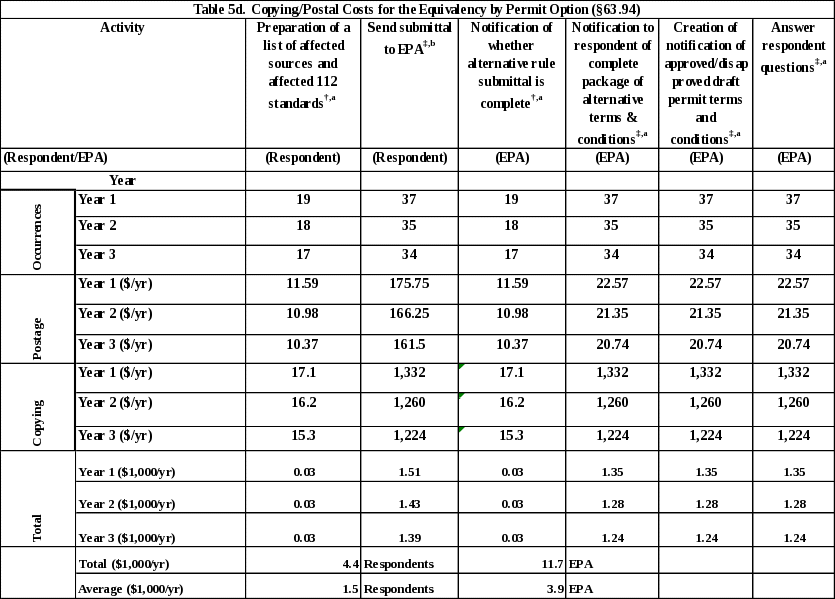
†Initial Equivalency by Permit Option approval.
‡Per Standard Equivalency by Permit Option approval.
a Assumes 1-lb. package.
b Assumes 2-oz. letter
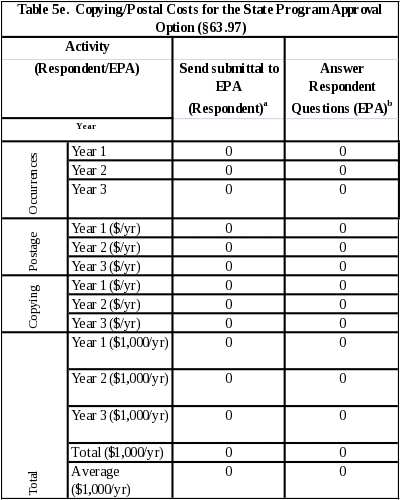
a Assumes 1-lb. package.
b Assumes 2-oz. letter
a Combined with one-time costs, above.
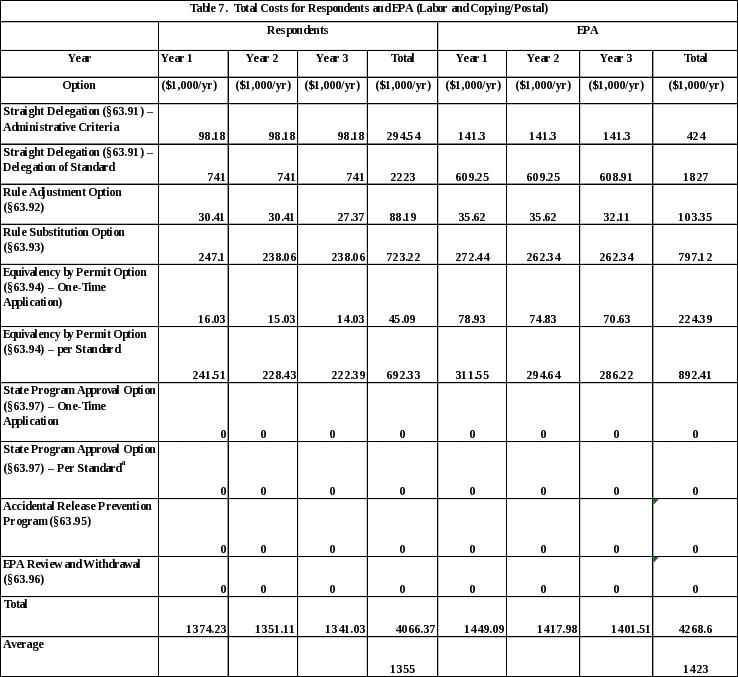
a Combined with one-time costs, above.
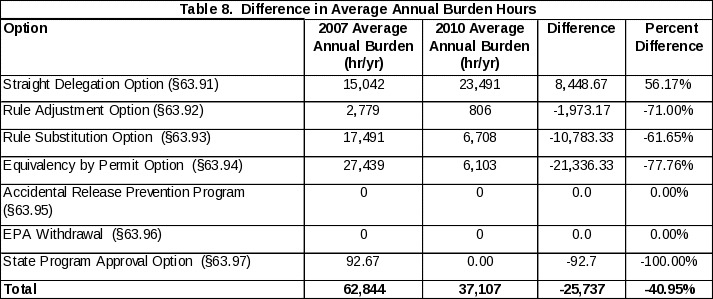

| File Type | application/vnd.openxmlformats-officedocument.wordprocessingml.document |
| File Title | Part A of the Supporting Statement |
| Author | Nan |
| File Modified | 0000-00-00 |
| File Created | 2021-02-01 |
© 2025 OMB.report | Privacy Policy
